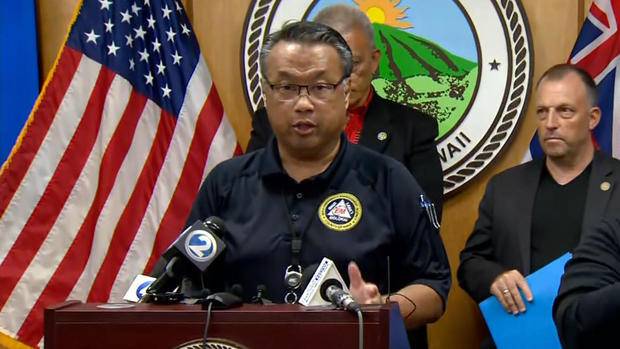Maui’s emergency management chief resigned a day after justifying his agency’s inability to activate its alert system during last week’s deadly Maui wildfire. which is the deadliest U.S. wildfire in more than a century, has killed at least 111 people, and hundreds more are still missing.

Officials from Maui County said in a news release that Herman Andaya, the MEMA Administrator, has resigned “effective immediately” for “health reasons.”
Mayor Richard Bissen of Maui said in a statement that “Given the gravity of the crisis we are facing, my team and I will be placing someone in this key position as quickly as possible and I look forward to making that announcement soon.”
Residents claimed they were not evacuated when the Maui wildfires started on August 8.
Every month on the first, Maui’s complex system—which includes 80 sirens throughout the island—is tested; in Lahaina, its 60-second tone is just a regular part of daily life. However, none of the island’s evacuation alarms sounded on the day of the fire.

Reporters questioned Andaya on Wednesday about if he regretted not sounding the sirens, and he replied, “I do not.”
He claimed that he had anticipated that the sirens, which are often used to warn of tsunamis, might have caused some residents of Lahaina to flee for higher ground, maybe into the path of the approaching wildfire.
However, as reported in Lahaina on Thursday, none of the locals accepted this explanation to be accurate, claiming that the siren would have given them vital notice of approaching danger.

On the official government website for Hawaii, “wildfires” are listed as one of the dangers the siren alert system can be used for. Due to Hurricane Dora’s close proximity and heavy winds that day, many people in Lahaina were at home without electricity. Additionally, many households who had lost service missed an SMS message the county sent.
With little time to get out, some people were unable to leave their homes, while others died in their vehicles while attempting to flee from the Maui wildfire. Many frightened citizens decided that the only way to save themselves was to dive into the water, where they clung to rocks and huddled together, attempting to dodge sparks that poured off burning buildings and not to breathe in the poisonous fumes.
The elderly citizens of the community were particularly at risk if the initial identifications of the dead victims are any indication. Six of the victims have so far been publicly identified. All were Lahaina residents. They are:
Robert Dyckman, 74
Buddy Jantoc, 79
Melva Benjamin, 71
Virginia Dofa, 90
Alfredo Galinato, 79
Donna Gomes, 71
Andaya didn’t have any experience responding to disasters, according to what CBS News learned. In 2017, the local news outlet Maui Now claimed that he had been hired above 40 other suitable candidates.
Wednesday, Andaya said that the claim “that I’m not qualified, I think, is incorrect.” He claimed that before taking over the emergency organization, he worked as the state’s deputy head of the Department of Housing and Human Concerns and the chief of staff to the mayor of Maui County for 11 years. Andaya claimed that at that time, he frequently reported to representatives of “emergency operations” and have undergone “numerous trainings.”
Investigations are still being conducted to determine the origin of the Maui wildfires. The local government response before and after the fires started is the subject of an inquiry by the Hawaii attorney general’s office.
In a video posted on social media on Thursday afternoon, Hawaii’s governor, Josh Green, said that at least 45% of the burn area had already been investigated and that 41 cadaver dogs had been sent in from the mainland U.S. to assist in searching the debris field. Approximately 500 FEMA employees, 270 Red Cross employees, approximately 400 members of the Hawaii National Guard, and nearly 200 U.S. members of the Army Reserve have been posted in Maui. The Lahaina wildfire is one of four that started on Maui on August 8 and has scorched a total area of 5.7 square miles. Out of the four flames, three are still active.
According to information released on Thursday by Maui County officials, the Upcountry/Kula fire, which had previously been referred to as a single fire, really consisted of two separate fires with “distinct origins.” They will now be referred to as the Olinda and Kula fires, according to officials.
19 homes were destroyed by the two fires, which started on the island’s eastern side.
According to officials, the Kula Fire had scorched roughly a third of a square mile and was 80% controlled, while the Olinda Fire had scorched 1.69 square miles and was 85% contained.

Firefighters fighting the two fires on the ground and from the air were still addressing “hot spots in gulches, forests, and other hard-to-reach places,” according to officials.
On Thursday, authorities said the 3.39 square mile Lahaina fire was 89% contained and there were “no active threats at this time.” Estimates indicate that at least 2,200 structures have been burned or damaged as a result of the Lahaina fire.
Many people in Lahaina appear to be focused on the future, rebuilding their houses and their town, nine days after the calamity. None claimed they had any plans to move or attempt a new way of life, despite the timeline—many stated they anticipated the reconstruction to take several years.
The words of Ms. Pedroza, “This is all I’ve ever known, this is my home, There is no selling. We want Lahaina back, and we’re going to get it.” were spoken.